Hybrid Metaheuristic Secondary Distributed Control Technique for DC Microgrids
Abstract
:1. Introduction
- A secondary distributed control approach for a DC-MG, introducing a novel weighting coefficient that simultaneously eliminates bus voltage fluctuations and ensures equitable current allocation across multiple ESs.
- A novel hybrid algorithm combining PSO and GWO is introduced to enhance coefficient selection for the distributed control strategy in the microgrid. This advanced algorithm optimizes the control coefficient, thereby ensuring that the control objectives are effectively achieved. By leveraging the strengths of both PSO and GWO, the proposed method provides a robust solution for fine-tuning the control coefficient, which enhances the overall performance and reliability of the DC-MG.
- A state-space model of a DC-MG incorporating eigenvalue observation analysis is developed to assess the effects of the optimized secondary distributed control on the microgrid’s stability. This analysis provides valuable insights into the system’s stability dynamics, helping to understand how the control strategy influences overall system performance.
- A real-time testing setup is constructed using MATLAB/Simulink® and implemented on a Speedgoat™ real-time target machine to validate the practical performance of the proposed approach in real-world applications.
2. Mathematical Model DC Microgrid Systems
2.1. Model of Buck Converter
2.2. Buck Converter Primary Controls
3. Secondary Distributed Controls
3.1. Communication Graph
3.2. Control Objectives
3.3. Proposed Design for Secondary Control
4. Enhanced Tuning Technique for Secondary Distributed Control
4.1. Particle Swarm Optimization (PSO)
4.2. Grey Wolf Optimizer (GWO)
4.3. Hybrid PSO-GWO Algorithm
4.4. Implementation of Hybrid PSO-GWO for Distributed Secondary Control
| Algorithm 1 HPSO-GWO Algorithm Implementation |
Run PSO to evaluate the fitness of all particles (47) Sort and index the fitness values of each particle. if = then stop else end if for current particle do if rand(0,1) < then assign values to a, d, and c ▹To avoid getting trapped in local minima else run PSO to evaluate the fitness of all particles end if Evaluate the fitness of all wolves if < then Compute new wolves position, (41) Substitute this position to PSO particles Run PSO else update the wolf position end if end for |
5. Results and Discussion
5.1. Stability Analysis
5.2. Control Objectives Realization
5.3. Validation through Real-Time Experimental Simulation
5.3.1. Current Allocation and Voltage Recovery Evaluation
5.3.2. Performance of Proposed Secondary Control during Varying Power Demand
5.3.3. Performance of Secondary Control during Communication Delay
5.4. Comparison with Alternative Secondary Distributed Control Methods
6. Conclusions
Author Contributions
Funding
Institutional Review Board Statement
Informed Consent Statement
Data Availability Statement
Acknowledgments
Conflicts of Interest
Abbreviations
| RESs | Renewable Energy Sources |
| DC-MG | DC Microgrid |
| MGs | Microgrids |
| AC | Alternating Current |
| ESs | Energy Sources |
| MHO | Meta-Heuristic Optimization |
| PSO | Particle Swarm Optimization |
| GWO | Grey Wolf Optimization |
| HPSO-GWO | Hybrid Particle Swarm Optimization-Grey Wolf Optimization |
| S-S | State-Space |
| CPL | Constant Power Load |
| DC | Direct Current |
| DERs | Distributed Energy Resources |
References
- Al-Tameemi, Z.H.A.; Lie, T.T.; Foo, G.; Blaabjerg, F. Optimal Coordinated Control of DC Microgrid Based on Hybrid PSO–GWO Algorithm. Electricity 2022, 3, 346–364. [Google Scholar] [CrossRef]
- Abhishek, A.; Ranjan, A.; Devassy, S.; Kumar Verma, B.; Ram, S.K.; Dhakar, A.K. Review of hierarchical control strategies for DC microgrid. IET Renew. Power Gener. 2020, 14, 1631–1640. [Google Scholar] [CrossRef]
- Gholami, M.; Pisano, A. Model Predictive Operation Control of Islanded Microgrids under Nonlinear Conversion Losses of Storage Units. Electricity 2022, 3, 33–50. [Google Scholar] [CrossRef]
- Ali, S.; Shengxue, T.; Jianyu, Z.; Ali, A.; Nawaz, A. An implementation of parallel buck converters for common load sharing in DC microgrid. Information 2019, 10, 91. [Google Scholar] [CrossRef]
- Rezaei, O.; Mirzapour, O.; Panahazari, M.; Gholami, H. Hybrid AC/DC provisional microgrid planning model considering converter aging. Electricity 2022, 3, 236–250. [Google Scholar] [CrossRef]
- Al-Ismail, F.S. DC microgrid planning, operation, and control: A comprehensive review. IEEE Access 2021, 9, 36154–36172. [Google Scholar] [CrossRef]
- Aluko, A.; Buraimoh, E.; Oni, O.E.; Davidson, I.E. Advanced distributed cooperative secondary control of Islanded DC Microgrids. Energies 2022, 15, 3988. [Google Scholar] [CrossRef]
- Al-Tameemi, Z.H.A.; Lie, T.T.; Foo, G.; Blaabjerg, F. Control strategies of DC microgrids cluster: A comprehensive review. Energies 2021, 14, 7569. [Google Scholar] [CrossRef]
- Nguyen, D.L.; Lee, H.H. A survey on cooperative control strategies for DC microgrids. Neurocomputing 2022, 486, 225–236. [Google Scholar] [CrossRef]
- Li, M.; Zhang, D.; Lu, S.; Tang, X.; Phung, T. Differential evolution-based overcurrent protection for DC microgrids. Energies 2021, 14, 5026. [Google Scholar] [CrossRef]
- Modu, B.; Abdullah, M.P.; Sanusi, M.A.; Hamza, M.F. DC-Based microgrid: Topologies, control schemes, and implementations. Alex. Eng. J. 2023, 70, 61–92. [Google Scholar] [CrossRef]
- Bharath, K.; Krishnan, M.M.; Kanakasabapathy, P. A review on DC microgrid control techniques, applications and trends. Int. J. Renew. Energy Res. (IJRER) 2019, 9, 1328–1338. [Google Scholar]
- Madurai Elavarasan, R.; Ghosh, A.; Mallick, T.K.; Krishnamurthy, A.; Saravanan, M. Investigations on performance enhancement measures of the bidirectional converter in PV–wind interconnected microgrid system. Energies 2019, 12, 2672. [Google Scholar] [CrossRef]
- Yaqub, R. Phasor Measurement Unit Assisted Inverter—A Novel Approach for DC Microgrids Performance Enhancement. Electricity 2021, 2, 330–341. [Google Scholar] [CrossRef]
- Sahoo, S.; Mishra, S.; Fazeli, S.M.; Li, F.; Dragičević, T. A distributed fixed-time secondary controller for DC microgrid clusters. IEEE Trans. Energy Convers. 2019, 34, 1997–2007. [Google Scholar] [CrossRef]
- Espina, E.; Llanos, J.; Burgos-Mellado, C.; Cardenas-Dobson, R.; Martinez-Gomez, M.; Saez, D. Distributed control strategies for microgrids: An overview. IEEE Access 2020, 8, 193412–193448. [Google Scholar] [CrossRef]
- Wan, Q.; Zheng, S. Distributed cooperative secondary control based on discrete consensus for DC microgrid. Energy Rep. 2022, 8, 8523–8533. [Google Scholar] [CrossRef]
- Gao, F.; Kang, R.; Cao, J.; Yang, T. Primary and secondary control in DC microgrids: A review. J. Mod. Power Syst. Clean Energy 2019, 7, 227–242. [Google Scholar] [CrossRef]
- Liu, X.K.; Jiang, H.; Wang, Y.W.; He, H. A distributed iterative learning framework for DC microgrids: Current sharing and voltage regulation. IEEE Trans. Emerg. Top. Comput. Intell. 2020, 4, 119–129. [Google Scholar] [CrossRef]
- Yuan, Q.F.; Wang, Y.W.; Liu, X.K.; Lei, Y. Distributed fixed-time secondary control for DC microgrid via dynamic average consensus. IEEE Trans. Sustain. Energy 2021, 12, 2008–2018. [Google Scholar] [CrossRef]
- Xing, L.; Cai, J.; Liu, X.; Fang, J.; Tian, Y.C. Distributed secondary control of DC microgrid via the averaging of virtual current derivatives. IEEE Trans. Ind. Electron. 2024, 71, 2914–2923. [Google Scholar] [CrossRef]
- Nguyen, D.L.; Lee, H.H. Accurate power sharing and voltage restoration in DC microgrids with heterogeneous communication time delays. IEEE Trans. Power Electron. 2022, 37, 11244–11257. [Google Scholar] [CrossRef]
- Guo, F.; Huang, Z.; Wang, L.; Wang, Y. Distributed event-triggered voltage restoration and optimal power sharing control for an islanded DC microgrid. Int. J. Electr. Power Energy Syst. 2023, 153, 109308. [Google Scholar] [CrossRef]
- Dong, M.; Li, L.; Nie, Y.; Song, D.; Yang, J. Stability analysis of a novel distributed secondary control considering communication delay in DC microgrids. IEEE Trans. Smart Grid 2019, 10, 6690–6700. [Google Scholar] [CrossRef]
- Mosaad, N.; Abdel-Rahim, O.; Megahed, T.F.; Rohouma, W.; Asano, T.; Abdelkader, S.M. An enhanced consensus-based distributed secondary control for voltage regulation and proper current sharing in a DC islanded microgrid. Front. Energy Res. 2023, 11, 1277198. [Google Scholar] [CrossRef]
- Sadabadi, M.S.; Mijatovic, N.; Dragičević, T. A Robust Cooperative Distributed Secondary Control Strategy for DC Microgrids with Fewer Communication Requirements. IEEE Trans. Power Electron. 2023, 38, 271–282. [Google Scholar] [CrossRef]
- Liu, X.K.; Wang, Y.W.; Lin, P.; Wang, P. Distributed supervisory secondary control for a DC microgrid. IEEE Trans. Energy Convers. 2020, 35, 1736–1746. [Google Scholar] [CrossRef]
- Yu, Y.; Liu, G.P.; Huang, Y.; Guerrero, J.M. Distributed learning-based secondary control for islanded dc microgrids: A high-order fully actuated system approach. IEEE Trans. Ind. Electron. 2024, 71, 2990–3000. [Google Scholar] [CrossRef]
- Guo, F.; Wang, L.; Wen, C.; Zhang, D.; Xu, Q. Distributed voltage restoration and current sharing control in islanded DC microgrid systems without continuous communication. IEEE Trans. Ind. Electron. 2020, 67, 3043–3053. [Google Scholar] [CrossRef]
- Keshta, H.E.; Saied, E.M.; Malik, O.P.; Bendary, F.M.; Ali, A.A. Fuzzy PI controller-based model reference adaptive control for voltage control of two connected microgrids. IET Gener. Transm. Distrib. 2021, 15, 602–618. [Google Scholar] [CrossRef]
- Gao, Z.M.; Zhao, J. An improved grey wolf optimization algorithm with variable weights. Comput. Intell. Neurosci. 2019, 2019, 2981282. [Google Scholar] [CrossRef]
- Hu, P.; Pan, J.S.; Chu, S.C. Improved binary grey wolf optimizer and its application for feature selection. Knowl.-Based Syst. 2020, 195, 105746. [Google Scholar] [CrossRef]
- Liu, J.; Wei, X.; Huang, H. An improved grey wolf optimization algorithm and its application in path planning. IEEE Access 2021, 9, 121944–121956. [Google Scholar] [CrossRef]
- Zhang, X.; Lin, Q.; Mao, W.; Liu, S.; Dou, Z.; Liu, G. Hybrid Particle Swarm and Grey Wolf Optimizer and its application to clustering optimization. Appl. Soft Comput. 2021, 101, 107061. [Google Scholar] [CrossRef]
- Shaheen, M.A.; Hasanien, H.M.; Alkuhayli, A. A novel hybrid GWO-PSO optimization technique for optimal reactive power dispatch problem solution. Ain Shams Eng. J. 2021, 12, 621–630. [Google Scholar] [CrossRef]
- Şenel, F.A.; Gökçe, F.; Yüksel, A.S.; Yiğit, T. A novel hybrid PSO–GWO algorithm for optimization problems. Eng. Comput. 2019, 35, 1359–1373. [Google Scholar] [CrossRef]
- Lasabi, O.; Swanson, A.; Jarvis, L.; Aluko, A.; Brown, M. Enhanced Distributed Non-Linear Voltage Regulation and Power Apportion Technique for an Islanded DC Microgrid. Appl. Sci. 2023, 13, 8659. [Google Scholar] [CrossRef]
- Zhang, N.; Yang, D.; Zhang, H.; Luo, Y. Distributed control strategy of DC microgrid based on consistency theory. Energy Rep. 2022, 8, 739–750. [Google Scholar] [CrossRef]
- Kaveh, A.; Zakian, P. Improved GWO algorithm for optimal design of truss structures. Eng. Comput. 2018, 34, 685–707. [Google Scholar] [CrossRef]
- Dahmani, S.; Yebdri, D. Hybrid algorithm of particle swarm optimization and grey wolf optimizer for reservoir operation management. Water Resour. Manag. 2020, 34, 4545–4560. [Google Scholar] [CrossRef]
- Almabrok, A.; Psarakis, M.; Dounis, A. Fast tuning of the PID controller in an HVAC system using the big bang–big crunch algorithm and FPGA technology. Algorithms 2018, 11, 146. [Google Scholar] [CrossRef]
- Ghanbari, N.; Bhattacharya, S.; Mobarrez, M. Modeling and stability analysis of a DC microgrid employing distributed control algorithm. In Proceedings of the 2018 9th IEEE International Symposium on Power Electronics for Distributed Generation Systems (PEDG), Charlotte, NC, USA, 25–28 June 2018; pp. 1–7. [Google Scholar]
- Lasabi, O.; Swanson, A.; Jarvis, L.; Aluko, A.; Goudarzi, A. Coordinated Hybrid Approach Based on Firefly Algorithm and Particle Swarm Optimization for Distributed Secondary Control and Stability Analysis of Direct Current Microgrids. Sustainability 2024, 16, 1204. [Google Scholar] [CrossRef]
- Chandrasekar, A.; Sengupta, S.; Hingane, S.; Gururaja, C.; Pandit, S. Comparative Analysis of Model Predictive Control (MPC) and Conventional Control in Supervisory Controller of a Retrofit HEV; Report 0148-7191, SAE Technical Paper; SAE International: Warrendale, PA, USA, 2017. [Google Scholar]
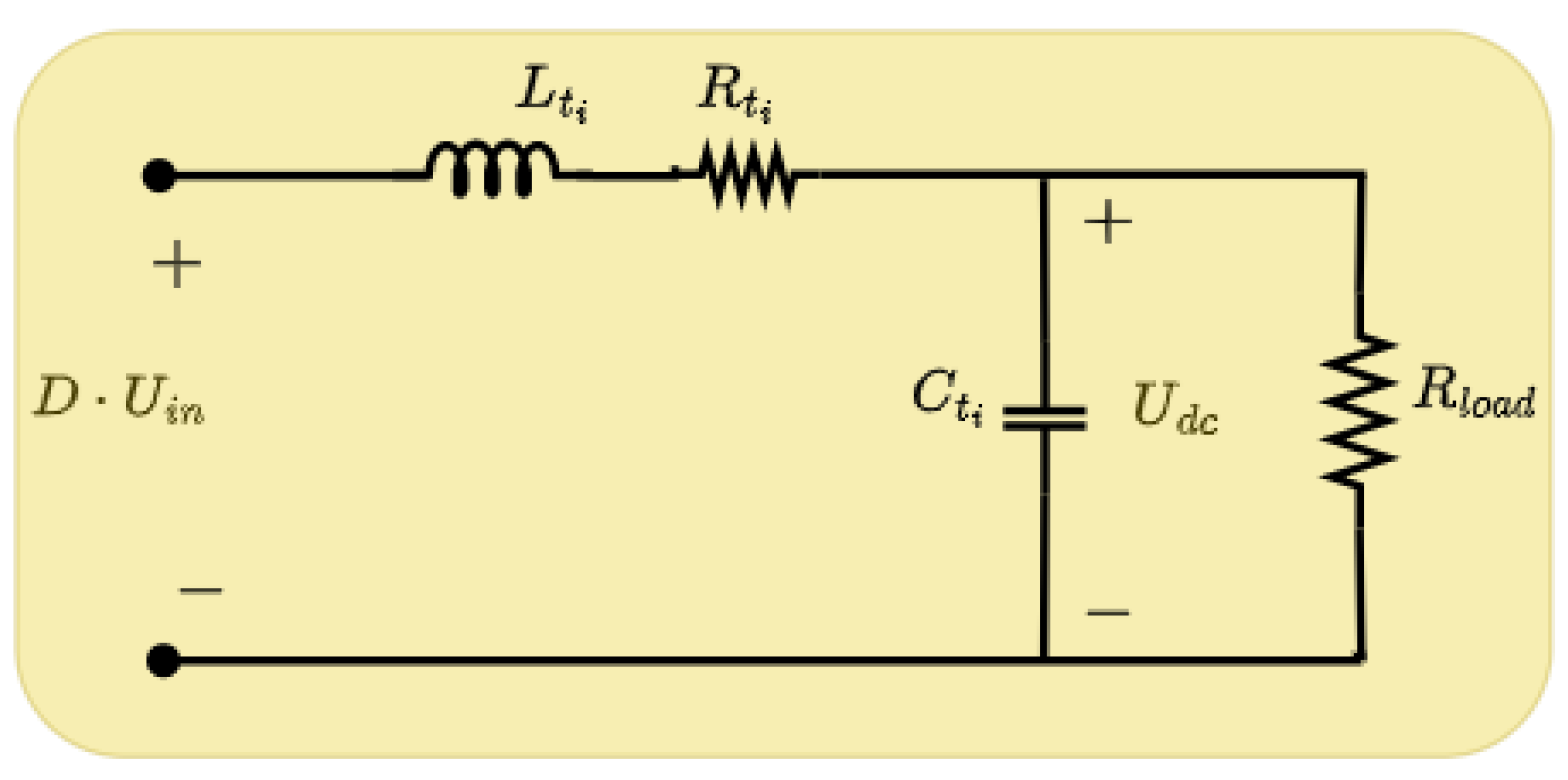
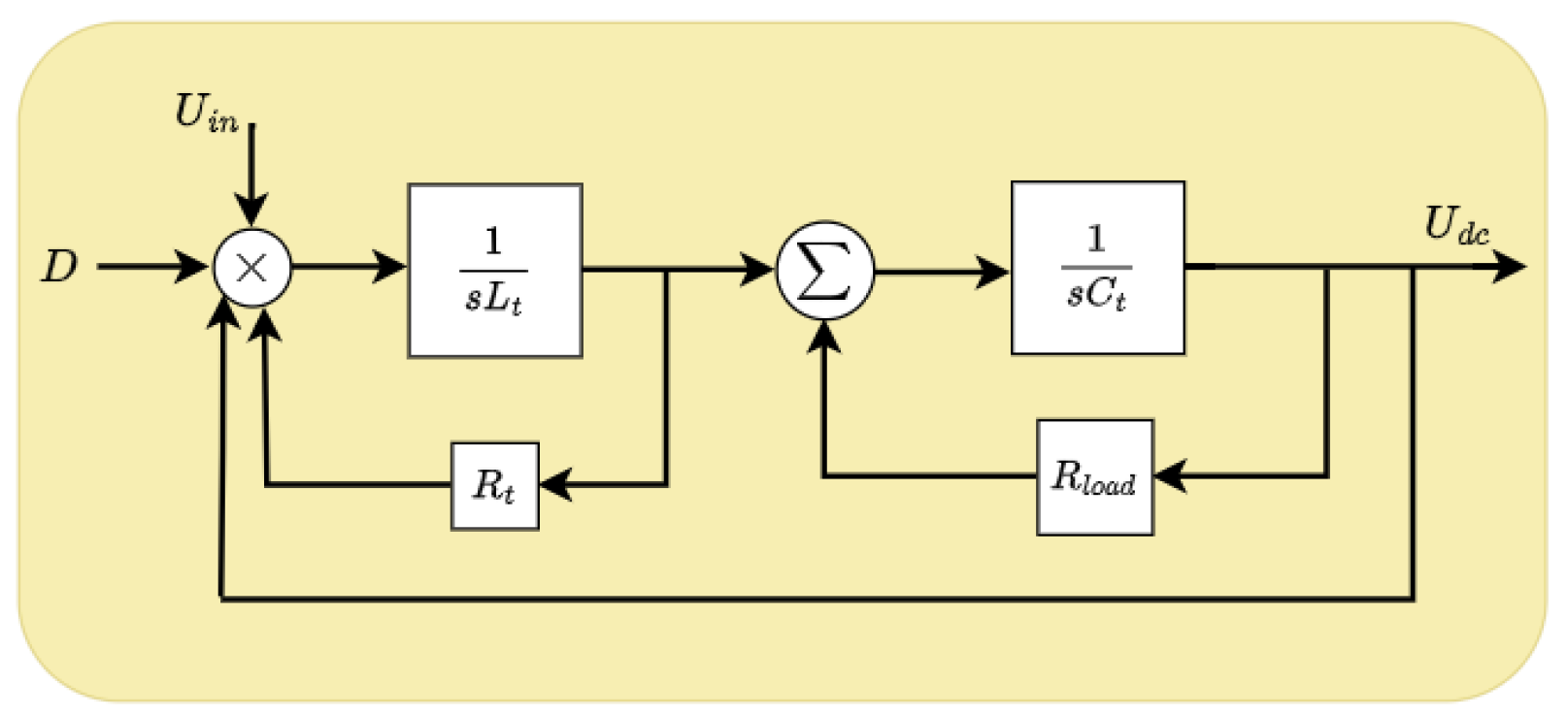
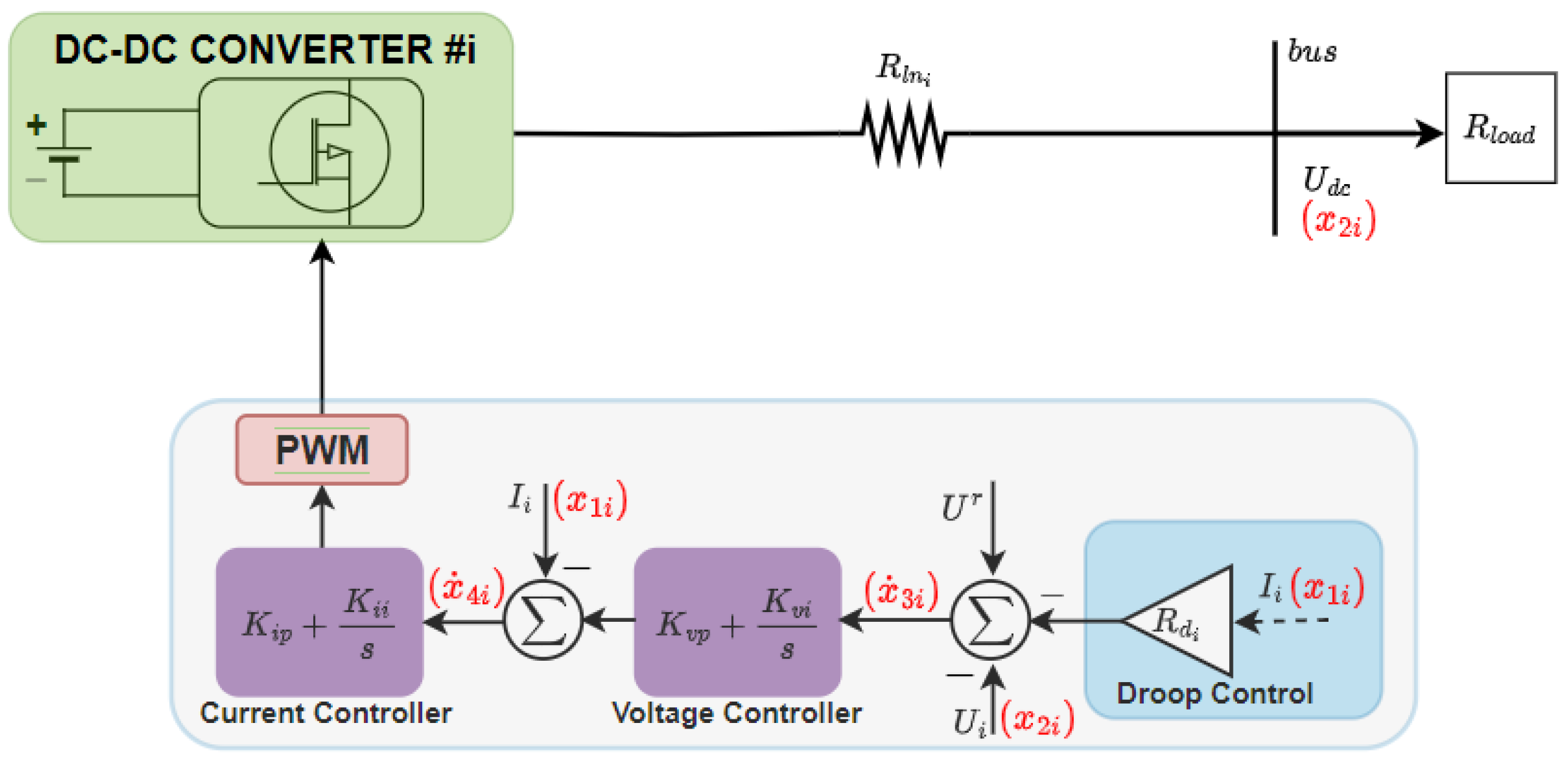

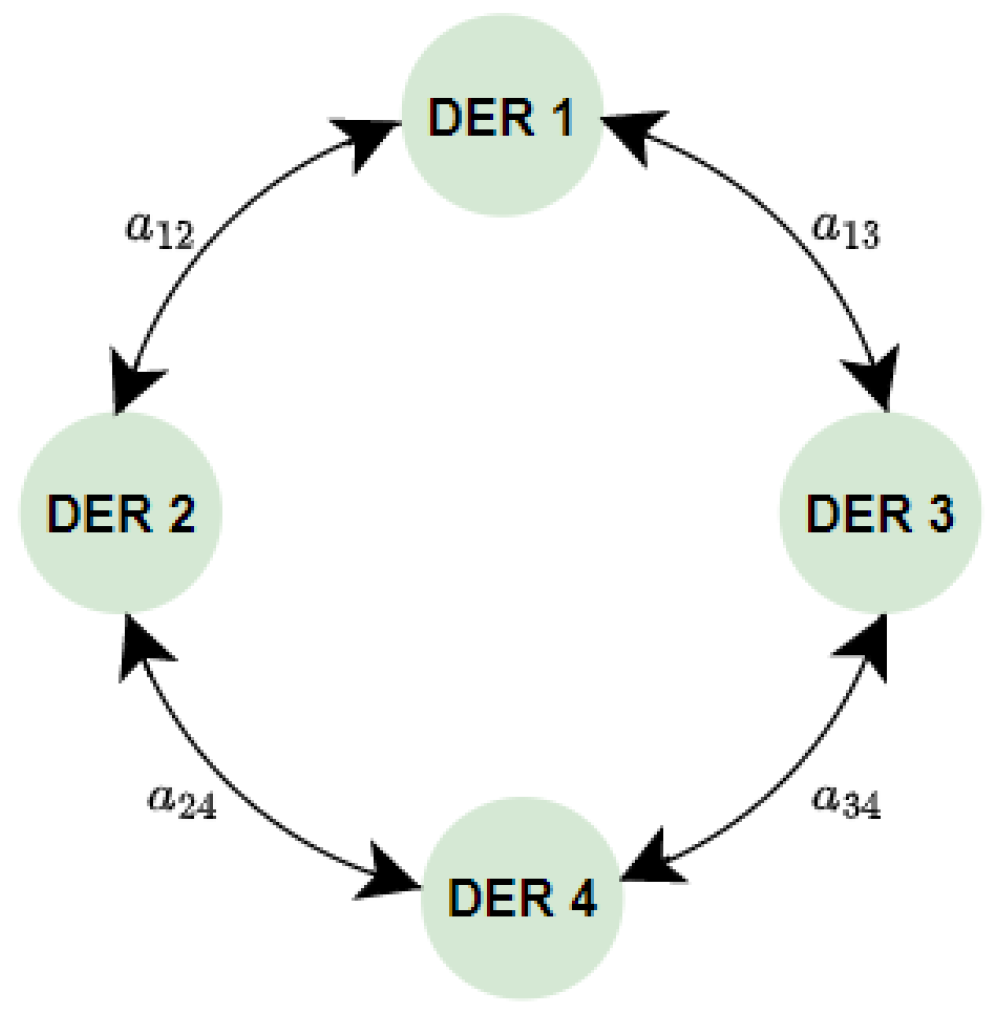

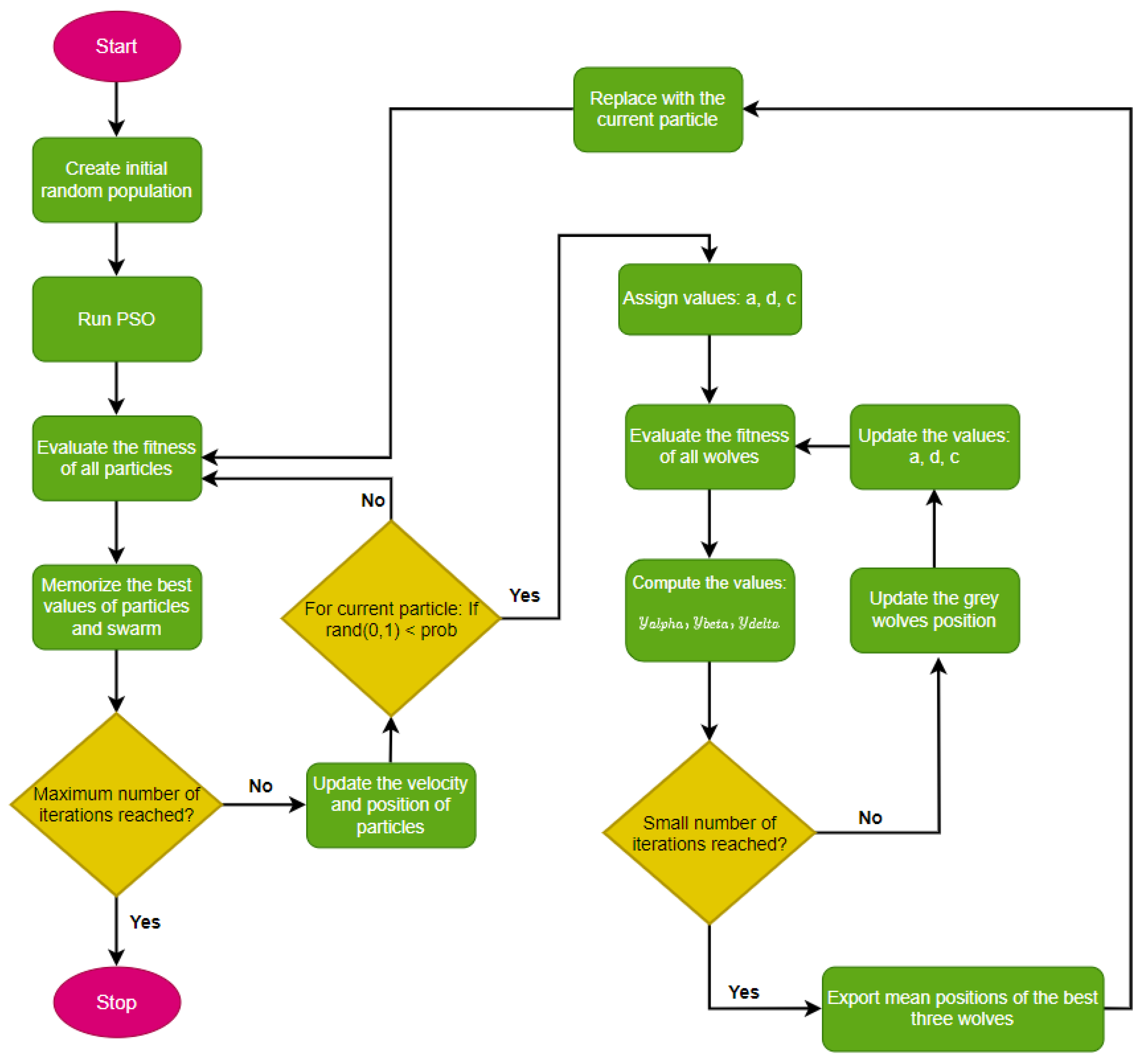
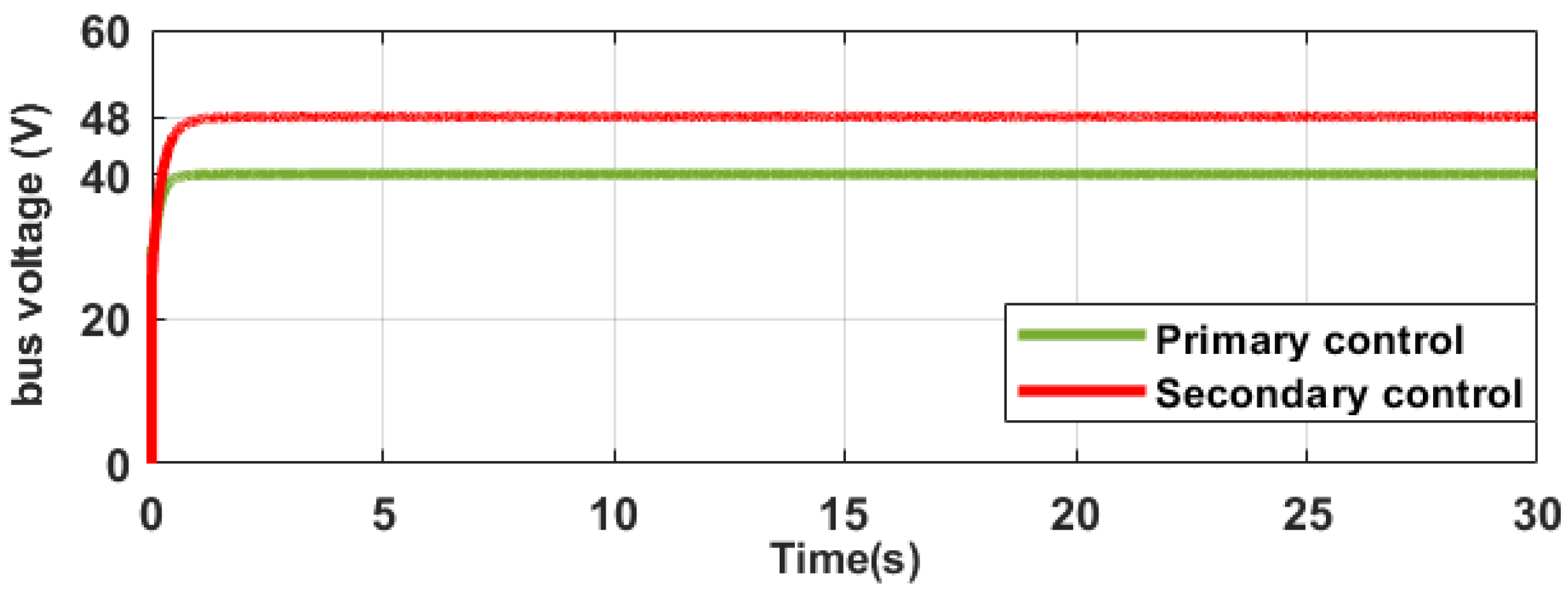
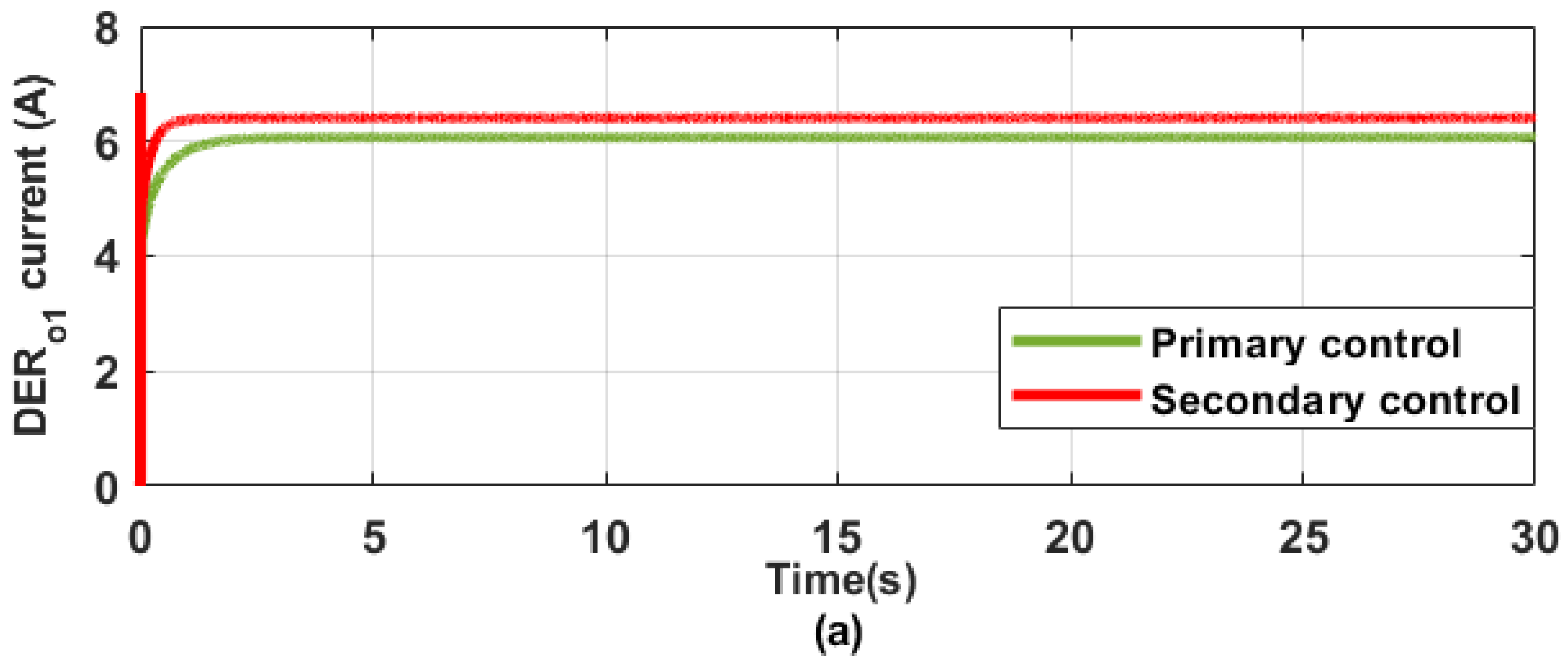
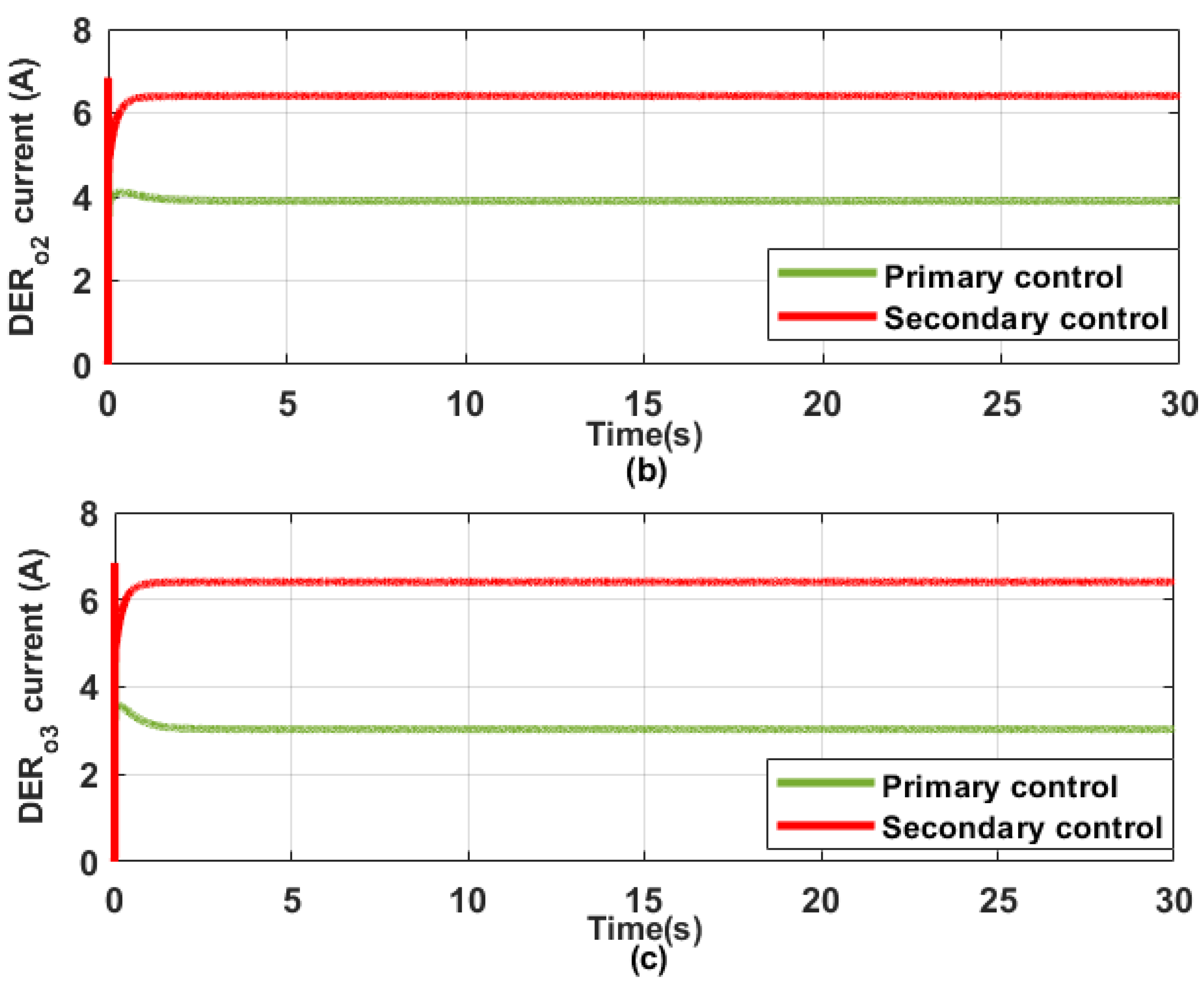
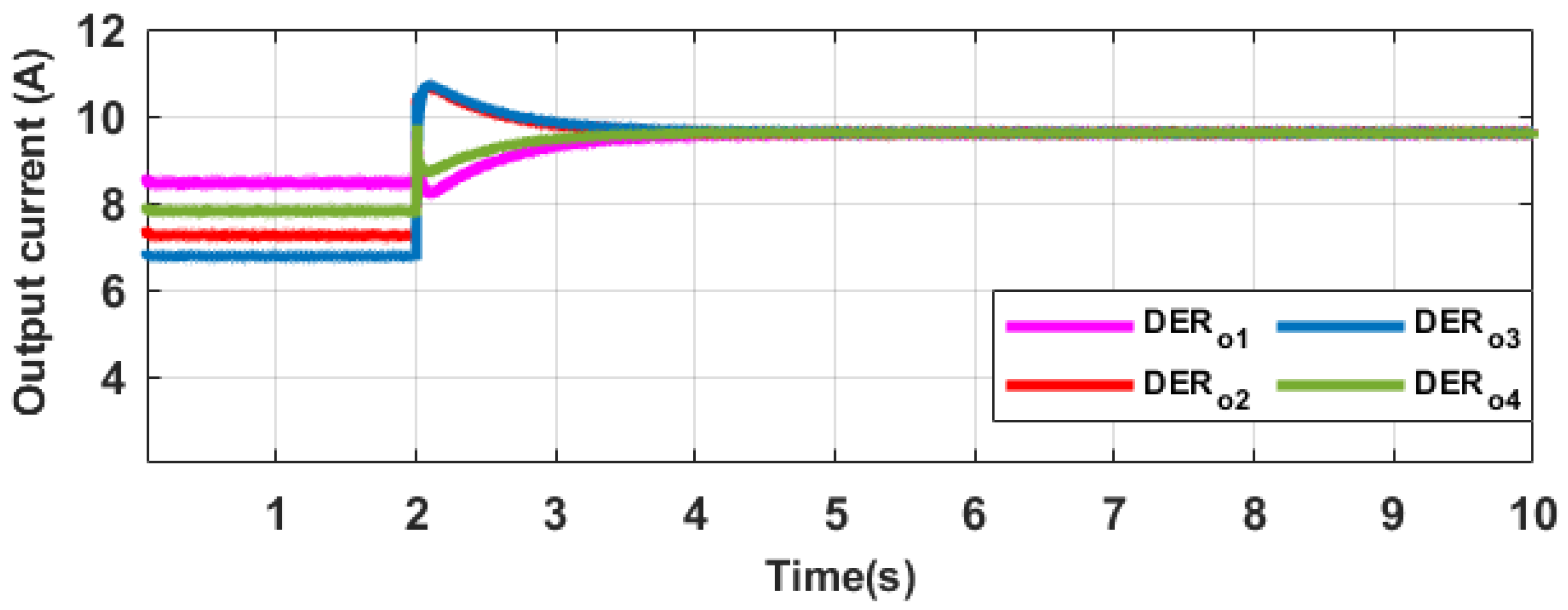
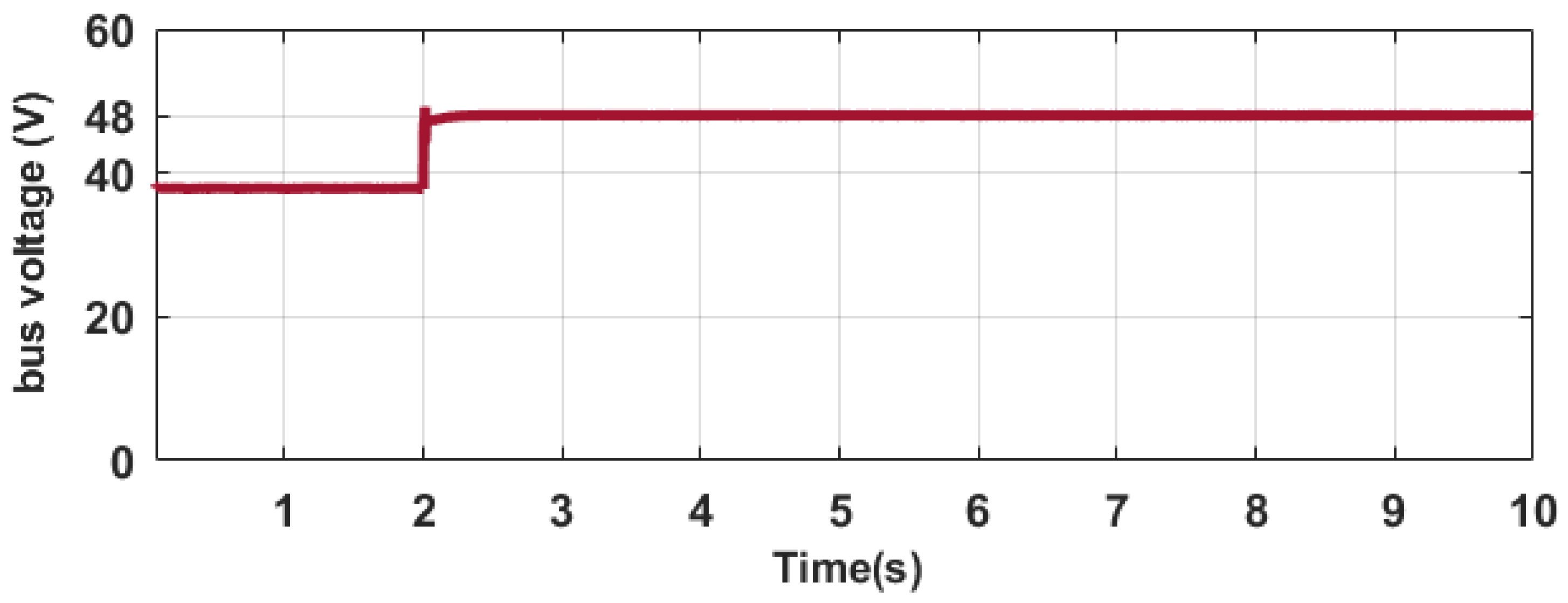
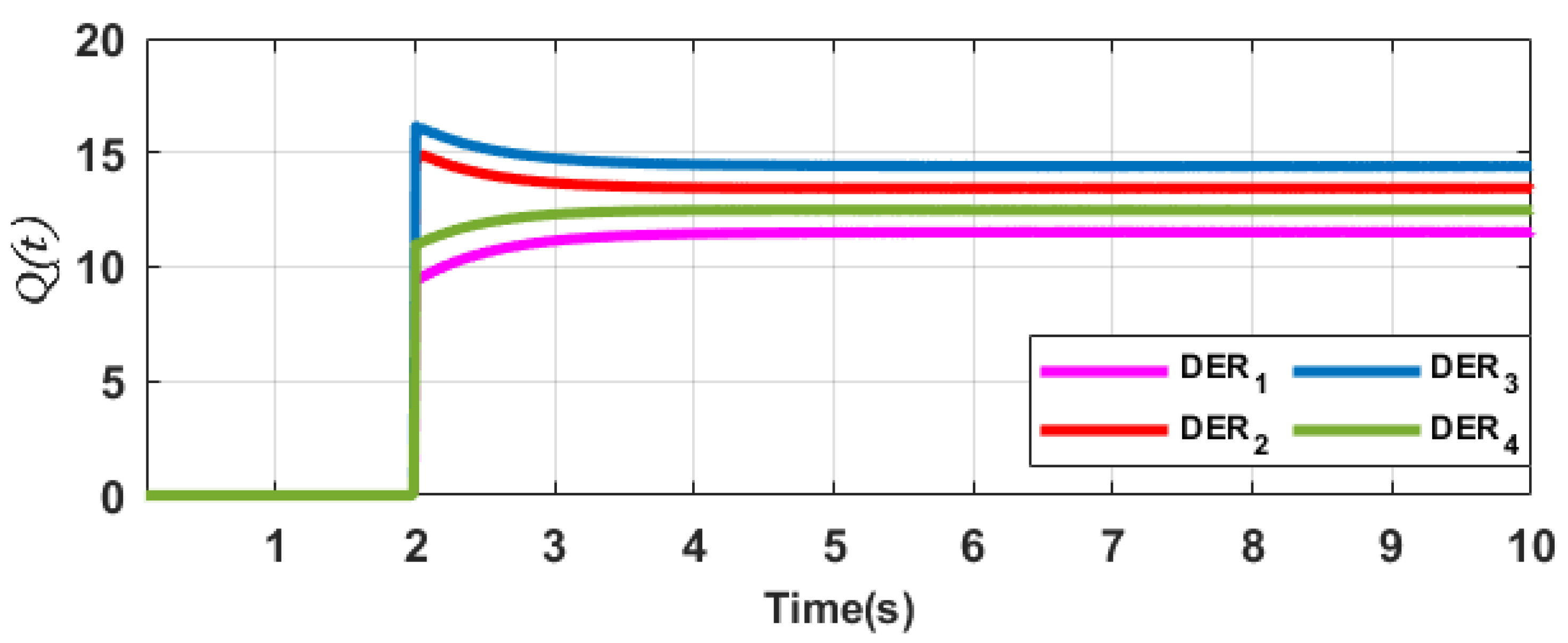

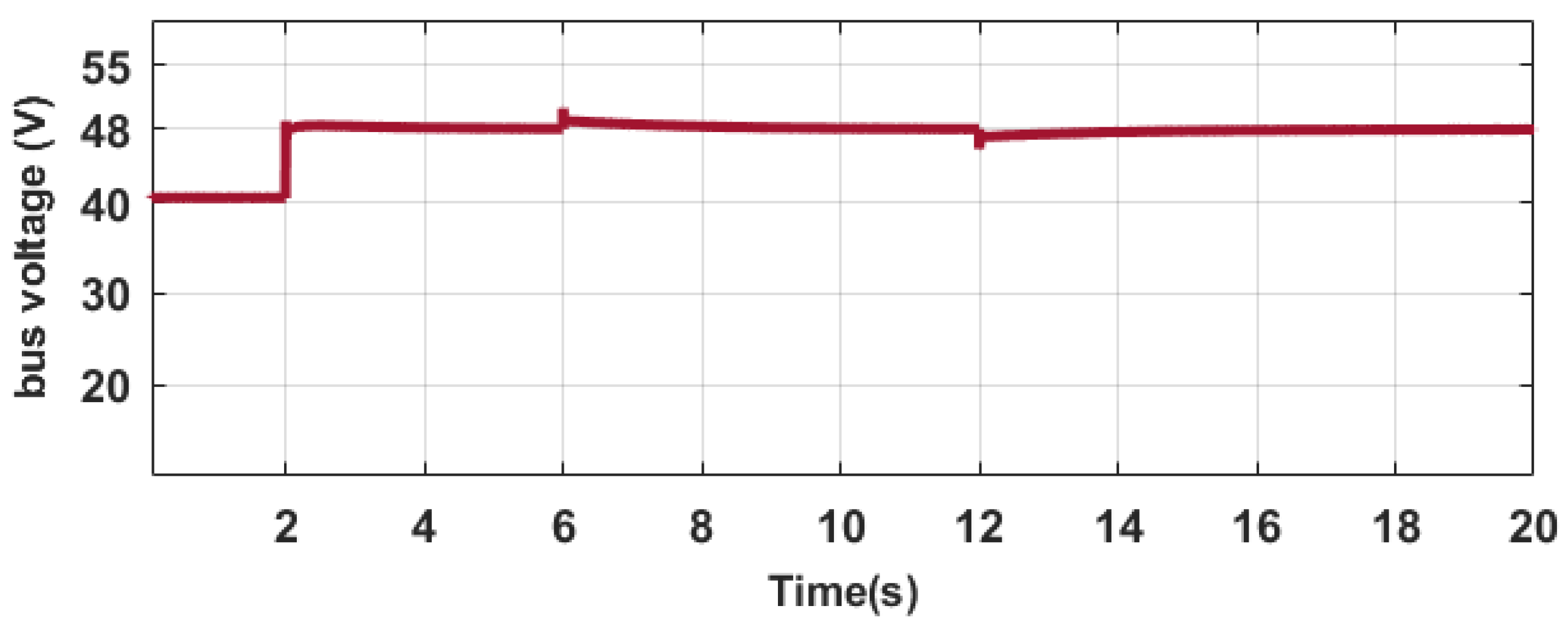
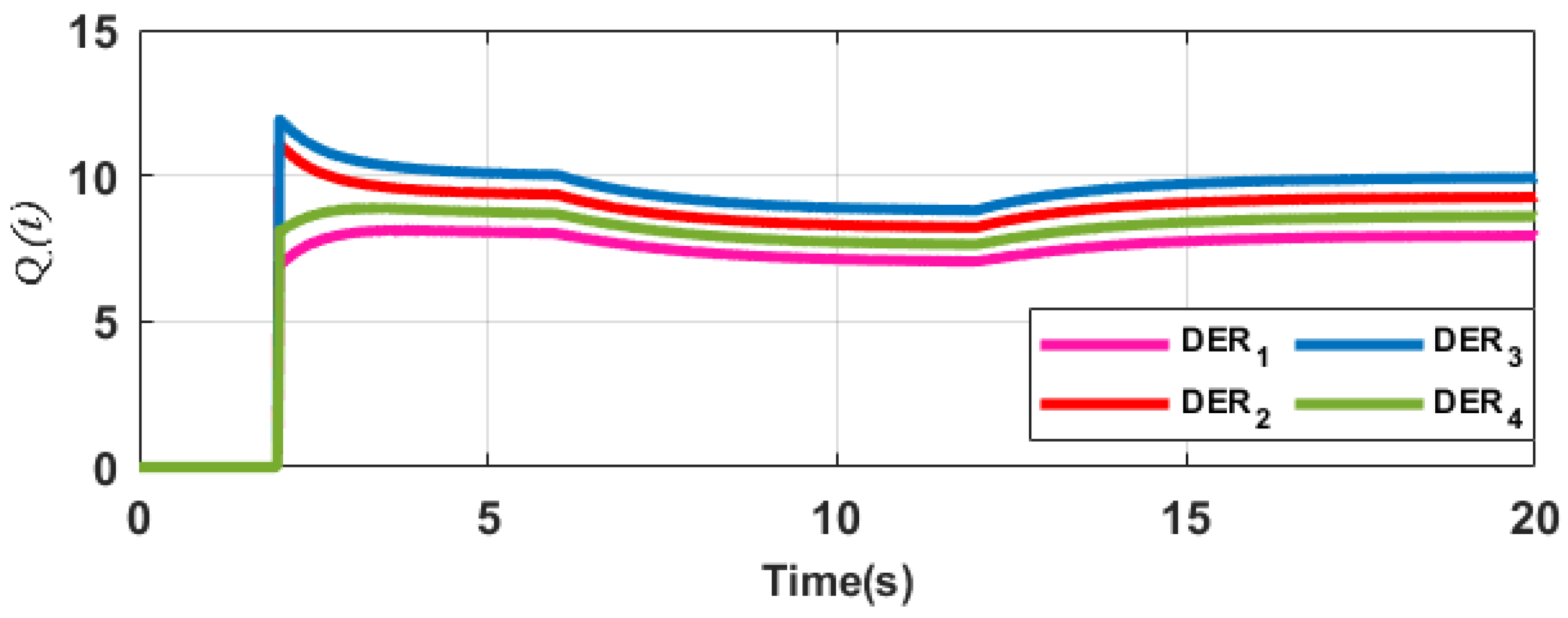
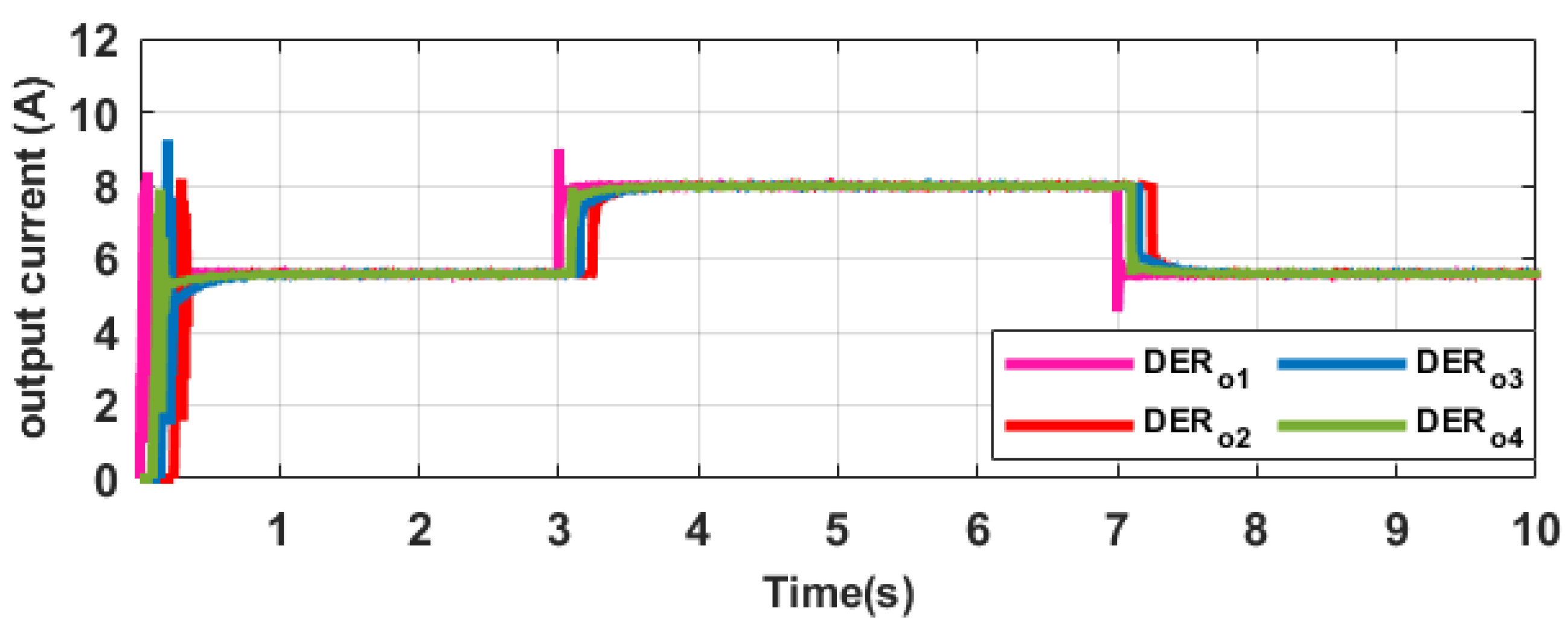
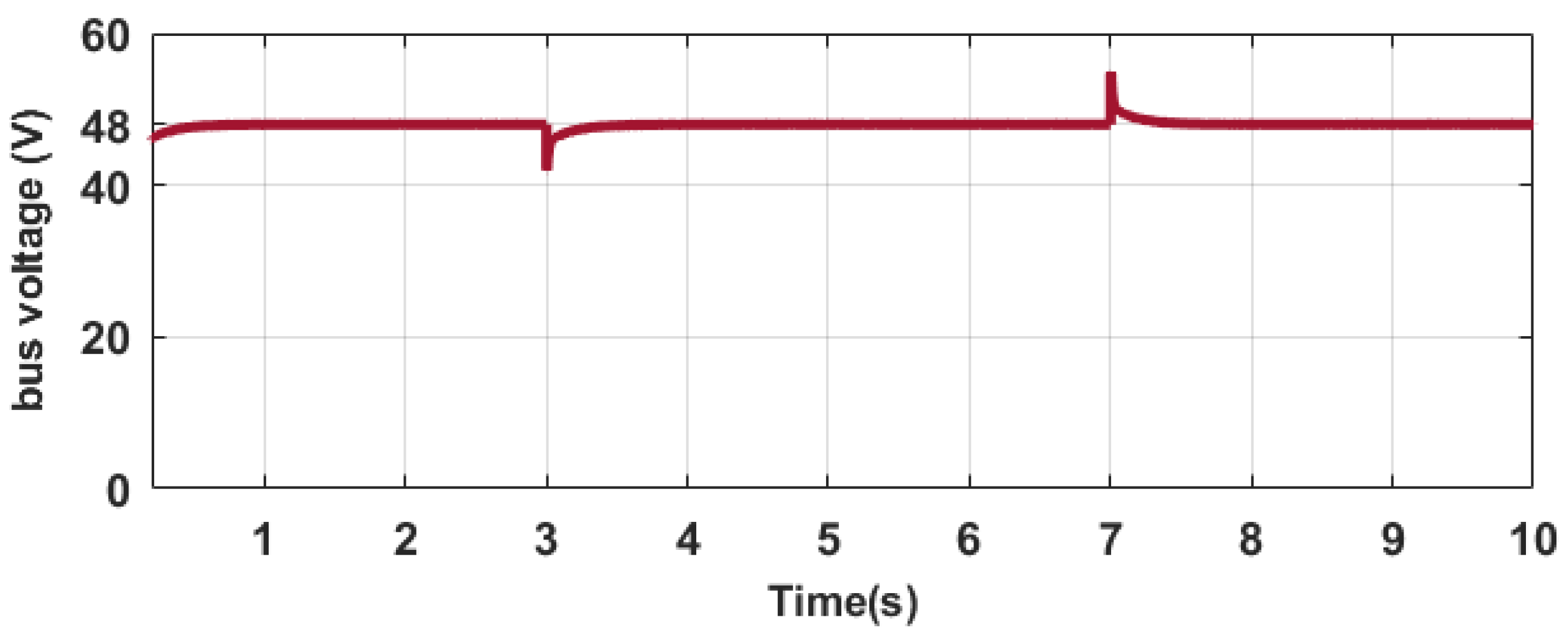
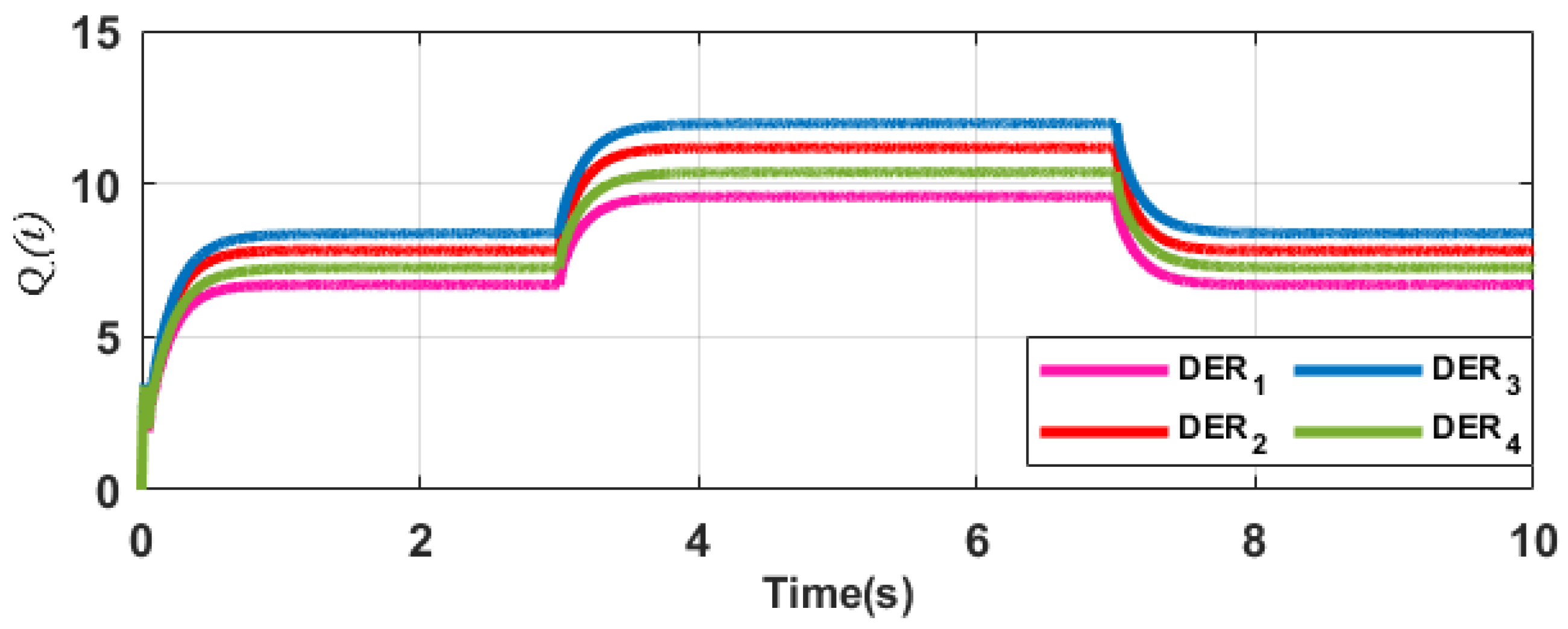
| Methods | Control Objective Realization | Robustness | Scalability | Communication Type | Implementation Complexity |
|---|---|---|---|---|---|
| [17,27,28] | good | moderate | moderate | reduced | complex |
| [22,25] | good | moderate | low | all-to-all | simple |
| [23,29] | better | low | low | all-to-all | simple |
| [24] | good | moderate | moderate | reduced | simple |
| [20] | good | moderate | moderate | reduced | complex |
| [26] | good | low | high | none | complex |
| Proposed Technique | excellent | high | moderate | reduced | complex |
| Rated Bus Voltage | 48 V | |
| Voltage Source | 100 V | |
| Switching Frequency | 10 kHz | |
| Converter Capacitance | C | 200 μF |
| Converter Inductance | L | 10 mH |
| Load | 3 , 5 , 5 | |
| HPSO-GWO Algorithm Parameters | ||
| No. of search agents | 30 | |
| Inertia constant | w | 0.5 + rand()/2 |
| Max. count of iterations | 500 | |
| No. of design variables | 1 | |
| Primary Controls | ||
| Current Loop | 2.5, 5 | |
| Voltage Loop | 0.248, 2 | |
| Droop resistance | 1 |
| −137.25 | − 198.70 + i347.11 | |
| 12.46 + i120.71 | −198.70 − i347.11 | |
| 12.46 − i120.71 | −6.16 | |
| −12.76 | − 1.45 | |
| −6.5 + i55.60 | −3.33 | |
| −6.5 + i55.60 | −0.80 + i4.08 | |
| −4.5 + i66.35 | −0.80 − i4.08 | |
| −4.5 + i66.35 | −370.06 | |
| −3.41 | −370.06 | |
| −3.41 | − 0.80 + i4.08 | |
| — | −0.80 − i4.08 | |
| — | −3.35 | |
| — | −3.35 |
| Switching Frequency | 10 kHz | |
| Sampling Frequency | 20 kHz | |
| Voltage Source | 100 V | |
| Nominal Bus Voltage | 48 V | |
| Converter Inductance | L | 20 mH |
| Converter Capacitance | C | 120 μF |
| Resistive Load | 4 , 6 | |
| Line Resistance | 0.3 , 0.4 , 0.6 , 0.7 | |
| Constant Power Load | 300 W | |
| Primary Controls | ||
| Current Loop | 0.05, 148 | |
| Voltage Loop | 0.259, 38 | |
| Droop resistance | 1 | |
| Secondary Controls | ||
| Variation Coefficient for Voltage | 1.35 | |
| Variation Coefficient for Current | 7.8 |
| Control Objectives | Proposed | ||||||
|---|---|---|---|---|---|---|---|
| Voltage Recovery | 2 s | 1.3 s | 1.72 s | 3 s | 1 s | 1.1 s | ≤0.4 s |
| Current Allocation | 2.8 s | 1.5 s | 2 s | 3.4 s | 1.6 s | 2.1 s | ≤1.4 s |
| Robustness | low | high | moderate | low | high | moderate | very high |
| Implementation Complexity | simple | complex | simple | simple | complex | complex | complex |
Disclaimer/Publisher’s Note: The statements, opinions and data contained in all publications are solely those of the individual author(s) and contributor(s) and not of MDPI and/or the editor(s). MDPI and/or the editor(s) disclaim responsibility for any injury to people or property resulting from any ideas, methods, instructions or products referred to in the content. |
© 2024 by the authors. Licensee MDPI, Basel, Switzerland. This article is an open access article distributed under the terms and conditions of the Creative Commons Attribution (CC BY) license (https://creativecommons.org/licenses/by/4.0/).
Share and Cite
Lasabi, O.; Swanson, A.; Jarvis, L.; Khan, M.; Aluko, A. Hybrid Metaheuristic Secondary Distributed Control Technique for DC Microgrids. Sustainability 2024, 16, 7750. https://doi.org/10.3390/su16177750
Lasabi O, Swanson A, Jarvis L, Khan M, Aluko A. Hybrid Metaheuristic Secondary Distributed Control Technique for DC Microgrids. Sustainability. 2024; 16(17):7750. https://doi.org/10.3390/su16177750
Chicago/Turabian StyleLasabi, Olanrewaju, Andrew Swanson, Leigh Jarvis, Mohamed Khan, and Anuoluwapo Aluko. 2024. "Hybrid Metaheuristic Secondary Distributed Control Technique for DC Microgrids" Sustainability 16, no. 17: 7750. https://doi.org/10.3390/su16177750






